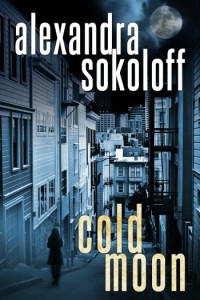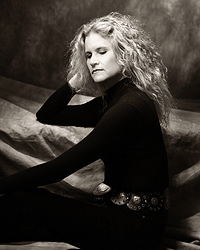 The following is a guest post by Alexandra Sokoloff, author of Cold Moon, the third book in the Huntress series. If you would like to write a guest post on my blog, please send me an e-mail at contact@cecilesune.com.
The following is a guest post by Alexandra Sokoloff, author of Cold Moon, the third book in the Huntress series. If you would like to write a guest post on my blog, please send me an e-mail at contact@cecilesune.com.
I’m often told that my thrillers are extremely visual and cinematic; I’m pretty sure that the comment I get most often from readers is “I could see the whole story like a movie playing in my head.” Well, coming from screenwriting as I do, I absolutely feel that my job as an author is to put a movie into my readers’ heads, so I’m glad it’s working out that way!
Setting and location are hugely important to my books. My first thrillers are on the supernatural side, and the house in a haunted house story (or a haunted dorm story like my ghost story The Harrowing) is every bit as much a character as the living ones. I’ve gone so far as to go live for weeks in a haunted mansion to collect realistic detail for the haunted mansion I was depicting in my poltergeist thriller, The Unseen.
But primarily my use of vivid locations comes from the filmmaking concept of setpiece scenes – so named because before the advent of location shooting, elaborate sets were built as backdrops to key scenes.
There’s a saying in Hollywood that “If you have six great scenes, you have a movie.”
Filmmakers take that “six great scenes” concept very literally. These setpiece scenes are also often called the “trailer scenes” or the “money scenes” (as opposed to “money shots” – that’s a whole different post!). As incensed as I am personally about how trailers these days give every single bit of the movie away, I understand that this is essential movie advertising: those trailer scenes have to seduce the potential audience by giving a good sense of the experience the movie is promising to deliver.
A really great setpiece scene is a lot more than just visually dazzling. It’s thematic, too, such as the prison (dungeon for the criminally insane) in The Silence of the Lambs. That is much more than your garden variety prison. It’s a labyrinth of twisty staircases and creepy corridors. And it’s hell: Clarice goes through – count ‘em – seven gates, down, down, down under the ground to get to Lecter. Because after all, she’s going to be dealing with the devil, isn’t she? And the labyrinth is a classic symbol of an inner psychological journey, just exactly what Clarice is about to go through. And Lecter is a monster, like the Minotaur, so putting him smack in the center of a labyrinth makes us unconsciously equate him with a mythical beast, something both more and less than human. The visuals of that setpiece express all of those themes perfectly (and others, too) so the scene is working on all kinds of visceral, emotional, subconscious levels. And all these visuals were on Thomas Harris’s page before they were translated to film.
If you watch or rewatch the erotic thriller Sea Of Love, which I did just recently, you’ll see how the storytellers work the sea images and the love images throughout the film. The film is often shot in blue tones and against backdrops of wide panes of glass, with moving shadows – all creating an undersea or aquarium effect, especially in the suspense scenes. The story explores themes of love, including obsessive love, and addiction – sex addiction and alcoholism. There are repeating visuals of bottles, glasses, drinking, nudity, erotic art, X-rated movie theaters, hookers.
The Harry Potter books are so crammed full of visual imagery it would take a book to go into it all (there probably is one, in fact…) The books play with all the classic symbols of witches, wizards and magic: owls, cats, gnome, newts, feathers, wands, crystals, ghosts, shapeshifters, snakes, frogs, rats, brooms (I don’t really have to keep going, do I?). Look at The Wizard of Oz (just the brilliant contrast of the black and white world of Kansas and the Technicolor world of Oz says volumes). Look at what Barbara Kingsolver does in Prodigal Summer, where images of fecundity and the, well, prodigiousness of nature overflow off the pages, revealing characters and conflicts and themes. Look at what Robert Towne and Roman Polanski do with water in Chinatown—and also, try watching that movie sometime with Oedipus in mind… the very specific parallels will blow you away. Take a look at Groundhog Day, which constantly provides groundhog images, images of stopped or handless clocks (and that malevolent clock radio!), an ice image of the eye of God, anthropomorphic weather.
In film, every movie has a production designer: one artist (and these people are genius level, let me tell you) who is responsible, in consultation with the director and with the help of sometimes a whole army of production artists) for the entire look of the film – every color, costume, prop, set choice.
With a book, guess who’s the production designer?
I am. The author is.
 As a screenwriter, I was used to having producers tell me a scene had to be set someplace else because it would be too expensive to shoot. But as an author I have the incredible advantage of an unlimited production budget. Whatever settings, crowds, mechanical devices, alien attacks or natural disasters I choose to depict, my only budget constraint is in my imagination. The most powerful directors in Hollywood would kill for a fraction of that power. Theoretically, they can’t even begin to compete.
As a screenwriter, I was used to having producers tell me a scene had to be set someplace else because it would be too expensive to shoot. But as an author I have the incredible advantage of an unlimited production budget. Whatever settings, crowds, mechanical devices, alien attacks or natural disasters I choose to depict, my only budget constraint is in my imagination. The most powerful directors in Hollywood would kill for a fraction of that power. Theoretically, they can’t even begin to compete.
So I approach setting as a production designer. My Thriller Award-nominated Huntress series (Huntress Moon, Blood Moon, Cold Moon) follows a haunted FBI agent’s interstate manhunt for what he believes may be a female serial killer. I get to show off the staggering beauty of my home state of California, and I have a lot of fun with locations. I get a lot of raves about a key scene that takes place in a butterfly colony in a eucalyptus grove. Now, growing up in California as I have, I couldn’t very well set a thriller on the central California coast and not use the monarch grove, and the visuals are breathtaking – but the monarchs also make a great metaphor for my killer. In another key scene (in Blood Moon) the memorial gardens of Golden Gate Park in San Francisco add a ritual mysticism to the aftermath of a murder scene. And using my beloved Haight Ashbury as a continuing setting in Blood Moon and Cold Moon gives those books the hint of magical forces that is a subtle part of the series.
I teach a popular Screenwriting Tricks for Authors writing workshop based on my Screenwriting Tricks for Authors blog and writing workbooks, and I always emphasize using locations thematically. I find authors really respond to the idea of setpieces, and I’m glad, because I don’t think there’s any better way to add visual excitement and thematic meaning to a story – in any medium.
So of course my question to the audience today is exactly the question I ask in my workshops: What are some great examples of memorable setpieces for you – in books or films?
About the author and her work: Alexandra Sokoloff’s Website.